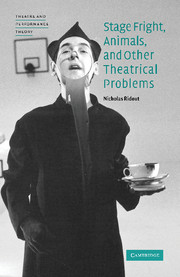3 - The animal on stage
Published online by Cambridge University Press: 04 December 2009
Summary
Mouse in the house
In the Winter of 2001, during a performance of Harold Pinter's The Caretaker at the Comedy Theatre in London, towards the end of Douglas Hodge's long account (as Aston) of his forced incarceration in a mental hospital and his treatment with electroconvulsive therapy, I thought I saw a mouse make an entrance from downstage left, crossing in a shallow diagonal and disappearing underneath the bed on which Hodge was seated. Upstage of Hodge, and more or less dead centre, sat Michael Gambon (as Davies), on another bed. After a short while in which I had time to run through various possibilities in my mind as to the exact nature of the phenomenon I had witnessed, the mouse reappeared, crossing in a far steeper diagonal from under Hodge's bed towards Gambon, who slid his right foot to one side to allow it past, and to disappear again beneath this second bed.
Quite apart from the additional excitement generated by the double entrance-exit routine executed by this non-human performer, and the odd way in which its activity was matrixed both by the mythology of romantically decrepit West End playhouses and the fictional setting of Aston's dilapidated room, one striking consequence of the stage mouse was the kind of conversation which sprang up around its appearance. The most thoroughly mined line of speculation was not just anthropomorphic but also economic and professional.
- Type
- Chapter
- Information
- Stage Fright, Animals, and Other Theatrical Problems , pp. 96 - 128Publisher: Cambridge University PressPrint publication year: 2006



